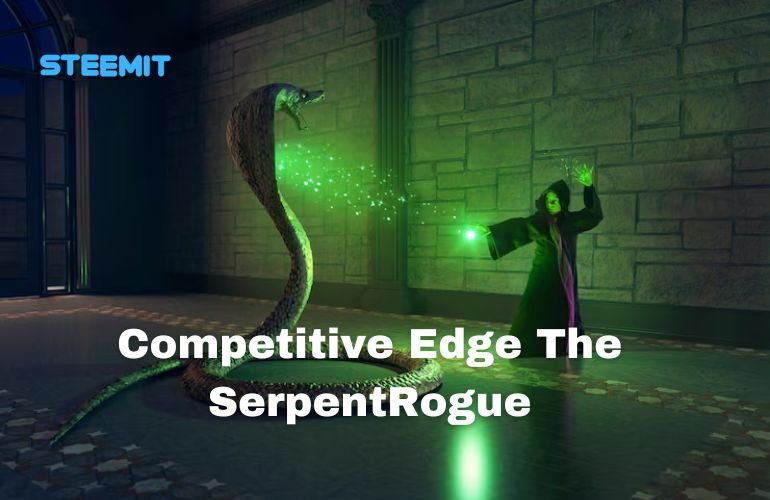The Competitive Edge The SerpentRogue isn’t just a game—it’s a challenge to rethink how you approach obstacles. Blending survival, strategy, and alchemy, it demands more than quick reflexes; it rewards foresight, creativity, and flexibility. Every decision—from crafting potions to managing alliances—shapes your path in a world where time and corruption never pause. This article breaks down the systems that define success in The SerpentRogue, revealing how its mechanics mirror real-world problem-solving. Whether you aim to dominate the game or sharpen your strategic mindset, understanding these principles offers a tangible advantage. Read on to discover what sets skilled players apart and how their methods transcend the screen.
Mastering Foundational Gameplay Mechanics
Character Control and Movement
Movement in The SerpentRogue is tied directly to survival. Tight control lets players dodge traps, evade enemies, and position themselves advantageously. Speed and responsiveness vary based on terrain—slippery slopes or dense foliage demand deliberate actions. Mastery here reduces unnecessary damage and conserves resources.
Combat Styles: Melee and Ranged
Melee combat relies on reading enemy patterns and striking during openings. Blocking or parrying conserves stamina, while mismanagement leaves players vulnerable. Ranged combat, including thrown alchemical items, offers flexibility but demands accuracy and inventory awareness. Switching between styles mid-fight keeps opponents off-balance.
Environmental Interaction
The world reacts to player choices. Climbing cliffs reveals shortcuts, while disturbing wildlife might trigger ambushes. Weather shifts, like fog or rain, obscure vision but mask sound, enabling stealth. Players adapt routes and tactics based on these variables to avoid wasted effort.
The Game Loop Cycle
- Preparation: Prioritize gathering specific materials for upcoming challenges. Crafting healing items or traps before leaving camp prevents crises during exploration.
- Exploration: Scour areas methodically—hidden caches or weak enemy patrols offer advantages. Overcommitting risks encounters without backup plans.
- Combat: Target high-threat enemies first. Use terrain to funnel foes or create choke points. Retreating to reset a fight is often smarter than enduring attrition.
- Rebuild: Post-conflict actions determine recovery speed. Repairing gear, refining unused resources, and analyzing past mistakes prepare players for future cycles.
These mechanics form a feedback loop: each phase informs the next. Efficient movement saves time for exploration, which yields better gear for combat, which secures safer rebuilding. Neglecting one element strains the entire system. Success hinges on balancing immediate needs with long-term goals.
Strategic Alchemy and Resource Management
Ingredient Identification and Prioritization
Not all resources hold equal value. Rare herbs like Ashthorn or Frostroot enable high-tier potions, while common mushrooms offer basic healing. Scarcity forces players to prioritize: stockpile versatile ingredients for emergencies, or spend them early to secure short-term gains. Map knowledge helps predict spawn locations, reducing wasted trips.

Crafting Efficiency
Experimentation reveals hidden recipes, but trial-and-error consumes materials. Start with known formulas—Fireburst Powder for crowd control or Vital Essence for health—to build a reliable base. Reserve experimental crafting for surplus resources. Always carry a Nullifying Agent to counteract accidental toxic brews.
Time and Corruption Trade-Offs
Every action advances in-game time, degrading unrefined ingredients. Decay turns potent reagents into useless sludge. Corruption escalates passively, triggering environmental hazards or enemy buffs. Balancing speed (to preserve resources) and caution (to avoid corruption spikes) defines alchemy’s risk-reward dynamic.
Combat Integration
Pre-brewed potions turn battles. Toss Blightbane Elixir to weaken armored foes or Mirage Mist to create diversions. Hoarding consumables risks losing them to sudden ambushes; proactive use disrupts enemy formations. Adjust recipes based on upcoming threats—anti-venom for swamp zones, frost resistance for mountain climbs.
Inventory Constraints
Carry limits prevent overstocking. Store non-essentials in safe zones, but retrieving them mid-expedition isn’t guaranteed. Assign slots strategically: two offensive items, one healing, one utility. Rotate stocks based on terrain—e.g., extra stamina tonics for dense forests.
Corruption Events
Randomized crises, like cursed storms or mutated wildlife, demand quick alchemical responses. Purification Salves halt corruption buildup, while Soulbind Oils temporarily pacify corrupted beasts. These events punish inflexible strategies, rewarding players who adapt recipes on-the-fly.
Alchemy isn’t a side activity—it’s the backbone of survival. Mismanagement cascades into combat failures and exploration dead-ends. Skillful players treat potions as extensions of their toolkit, not last-resort crutches.
Adaptive Tactics for Dynamic Challenges
Responding to Corruption Events
Corruption events disrupt stable strategies. Mutated enemies gain resistance to standard attacks, while environmental decay limits safe zones. Immediate adaptation is key: switching to Purification Salves slows corruption spread, while Soulbind Oils pacify aggressive beasts temporarily. Pre-planning escape routes or designating “clean” zones for retreat minimizes chaos during these crises.
Environmental Hazards and Mitigation
Weather shifts and terrain alterations force tactical pivots. Heavy rain extinguishes fire-based alchemy but muffles footsteps, enabling stealth. Ice-covered ground penalizes careless movement but allows sliding attacks. Players adjust by carrying terrain-specific tools—Frost Grips for icy slopes, Ember Stones to ignite damp kindling.
Countering Unexpected Threats
Ambushes or resource shortages test preparedness. A flexible inventory—balanced between offense, defense, and mobility—lets players improvise. For example, Smoke Pellets obscure vision for retreats, while Thorn Traps buy time to regroup. Memorizing enemy spawn triggers reduces surprise encounters.
Loadout Optimization
Tailor gear to anticipated challenges. Facing armored foes? Equip Acid Vials to bypass defenses. Exploring dark caves? Prioritize light sources like Glow Moss. Post-mission reviews inform future loadouts: if stamina shortages caused issues, allocate more slots to energy tonics.
Learning from Setbacks
Failures highlight strategic gaps. A wiped inventory after an ambush signals over-reliance on consumables. Repeated deaths to a boss may indicate poor timing or misread patterns. Replay logs or community guides to identify fixes, such as adjusting attack rhythms or repositioning during fights.
Precision Timing in Execution
Actions succeed or fail based on when they’re deployed. Strike enemies during recovery animations to maximize damage. Deploy Mirage Mist just before an enemy’s alert phase to redirect their focus. Delay using rare potions until critical moments—wasting them on minor skirmishes risks shortages during boss battles.
Adaptation isn’t optional. Static plans crumble under The SerpentRogue’s unpredictability. Players thrive by treating each challenge as a puzzle, blending pre-planned strategies with on-the-spot creativity. Mastery lies not in avoiding surprises, but in reshaping chaos into opportunities.
Social Dynamics and Reputation Building
NPC Interactions and Trust
Interactions with non-playable characters shape opportunities and risks. Merchants offer rare items at lower prices if trust is high, while hostile factions may ignore players with neutral reputations. Completing tasks—such as retrieving lost artifacts or resolving disputes—increases favor. Broken promises or aggressive actions degrade relationships, locking out quests or triggering vendettas. Observing NPC routines reveals preferences: some value altruism, others reward cunning.
Moral Choices and Consequences
Decisions ripple through the game world. Saving a village from bandits might earn allies, while looting abandoned homes could attract thieves. Morality isn’t binary; short-term gains often clash with long-term stability. For example, betraying a faction grants immediate rewards but isolates the player during later crises. Reputation tiers unlock unique dialogues, altering how characters react to requests or threats.
Alliances and Beast Taming
Forming alliances provides tangible benefits. A blacksmith ally might repair gear at no cost, while scouts share maps of hidden areas. Beast taming introduces companions: wolves track enemies, hawks scout ahead, and bears absorb damage in combat. These companions require upkeep—feeding and healing—but offset risks in hostile zones. Losing a tamed beast impacts morale, temporarily reducing stamina regeneration.
Reputation as Currency
High-standing factions grant access to restricted areas or discounted training. Conversely, infamy attracts mercenaries seeking bounties. Neutrality allows players to manipulate rival groups, pitting them against each other to create distractions. Balancing multiple reputations demands careful negotiation; overcommitting to one faction alienates others.
Dynamic Reactions
NPCs remember player behavior. Repeated generosity lowers prices, while theft triggers heightened security. Characters gossip about past deeds, influencing how strangers respond. A notorious reputation might intimidate weak foes but provoke stronger enemies to attack preemptively.
Social systems in The SerpentRogue mirror real-world networks. Trust accelerates progress, but manipulation opens shortcuts. Players weigh immediate benefits against future repercussions, crafting a persona that aligns with their survival strategy. Every interaction becomes a calculated step toward dominance or diplomacy.
Real-World Applications of In-Game Skills
Strategic Thinking in Business
The SerpentRogue’s resource management mirrors entrepreneurial decision-making. Allocating limited assets, anticipating market shifts, and pivoting during crises align with gameplay’s preparation and rebuild phases. For instance, hoarding in-game materials parallels cash reserves in startups—spending too early risks shortages, while excessive caution stalls growth.
Mental Agility in Athletics
Quick tactical shifts during combat resemble in-game adjustments athletes make mid-competition. A basketball player reading defenses or a climber altering routes under pressure both rely on pattern recognition and split-second choices, much like dodging corrupted enemies or adapting to weather changes.
Resilience Through Iterative Learning
Repeated failures in the game normalize setbacks as feedback, not defeat. This mindset applies to skill development—a musician mastering a complex piece or a coder debugging software iteratively benefits from viewing obstacles as solvable puzzles.
Long-Term Planning and Delayed Gratification
Investing in rare ingredients for future potions mirrors retirement savings or career-building. Players learn to sacrifice immediate rewards (e.g., using a powerful potion now) for larger payoffs later, a principle applicable to education or financial planning.
Social Navigation and Professional Networks
NPC reputation systems reflect workplace dynamics. Building trust with colleagues or clients opens opportunities, while burning bridges limits options. Just as in-game factions reward loyalty, real-world networks thrive on consistent, ethical engagement.
Adaptation Under Pressure
Corruption events train composure during chaos. Emergency responders or nurses triaging crises employ similar calm prioritization, assessing threats and allocating resources swiftly without succumbing to panic.
The SerpentRogue’s systems aren’t abstract—they’re microcosms of real challenges. Players unknowingly drill skills transferable to careers, hobbies, and personal growth. The game’s demand for flexibility, analysis, and persistence cultivates a mindset that thrives beyond the screen.
Cultivating a Legacy of Mastery
The SerpentRogue transcends entertainment by framing adversity as a classroom. Its systems—alchemy’s resource trade-offs, combat’s demand for adaptability, reputation’s mirroring of social nuance—train players to dissect problems holistically. Success isn’t about memorizing steps but internalizing a mindset: observe, analyze, act, revise.
These principles extend beyond the game. A business leader optimizing workflows, an athlete refining techniques, or an artist iterating drafts all engage in similar cycles. The game’s friction—time decay, corruption, unpredictable threats—mimics real-world volatility, conditioning players to thrive under pressure rather than retreat.

Mastery in The SerpentRogue isn’t a trophy; it’s a blueprint. Each playthrough reinforces that setbacks are data, alliances are multipliers, and preparation outmuscles raw skill. The true competitive edge lies not in winning a single battle, but in reshaping how you approach every challenge.
This game doesn’t just test reflexes—it forges thinkers. Whether you seek dominance in its world or growth in your own, the lessons linger long after the screen fades.
Conclusion
The SerpentRogue challenges players to rethink problem-solving through its intricate systems of strategy and adaptation. By blending alchemy’s resource management, combat’s tactical demands, and social dynamics’ moral complexity, the game shapes how you approach obstacles both on and off-screen. Its lessons—prioritizing flexibility, analyzing failures, and balancing risk—prepare you for challenges in careers, creative pursuits, and personal growth. More than a test of skill, The SerpentRogue becomes a mirror, reflecting how disciplined thinking and resilience turn volatility into advantage. Whether you play to conquer its world or to sharpen your mind, the game leaves a lasting imprint: mastery isn’t about perfection, but progress.





